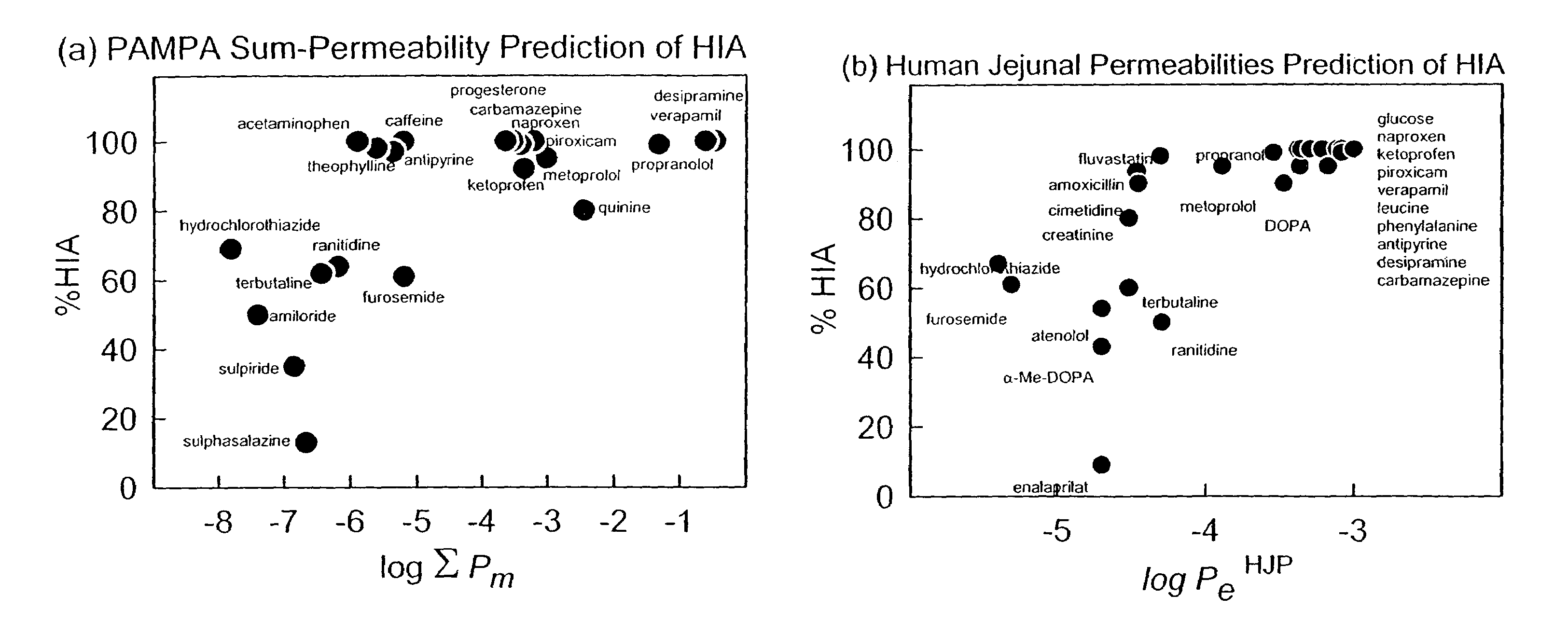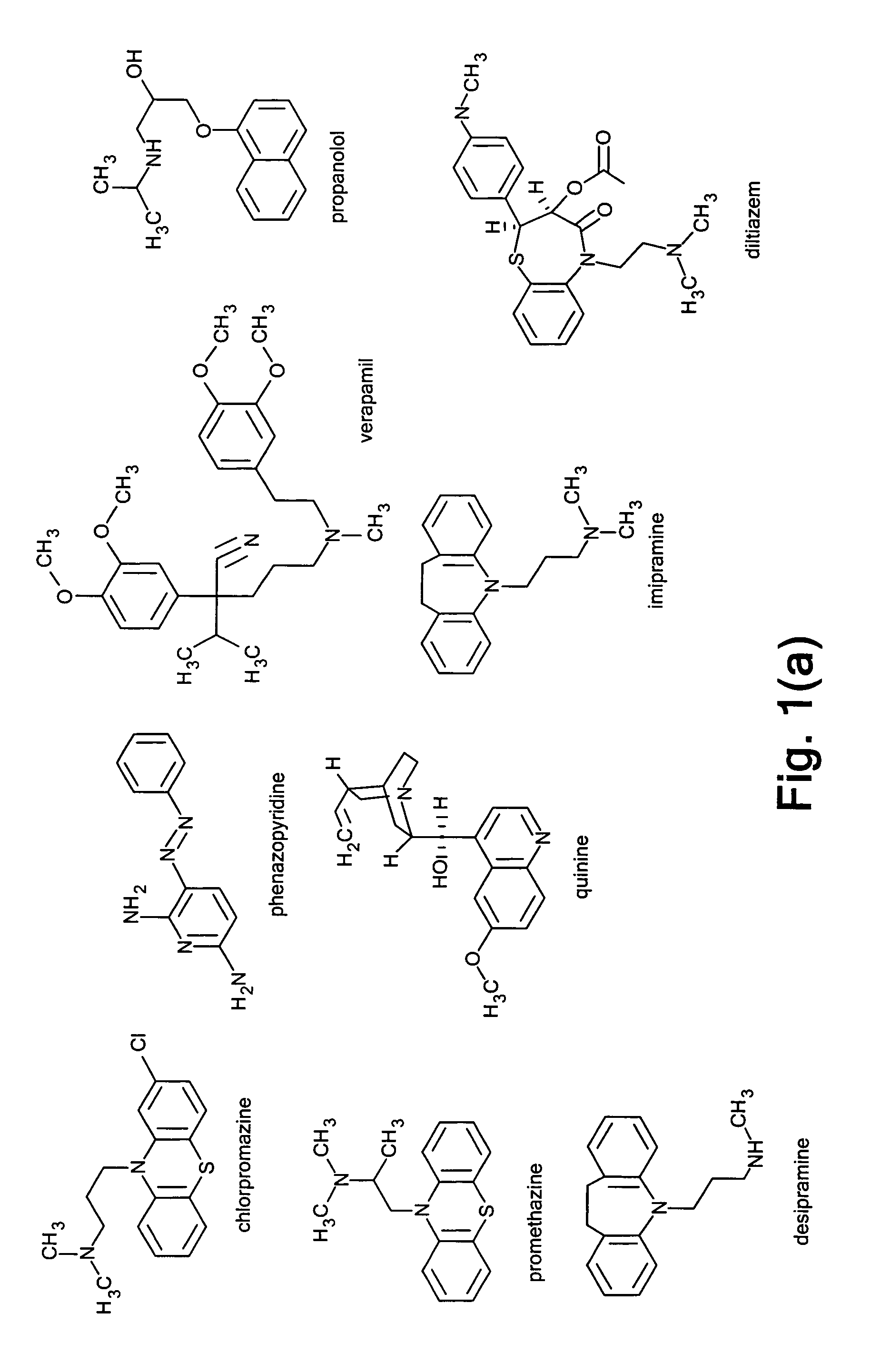Method and apparatus for improving in vitro measurement of membrane permeability of chemical compounds
- Summary
- Abstract
- Description
- Claims
- Application Information
AI Technical Summary
Benefits of technology
Problems solved by technology
Method used
Image
Examples
example 1
Apparatus of FIGS. 2–4: Effective Permeability and Membrane Retention Determined by the Improved PAMPA Method, using Acceptor Sink and Gradient-pH Conditions
[0094]FIG. 2 summarizes the apparatus detailed below, with FIG. 3 showing the permeation cell (39) used. The general PAMPA method used to determine permeability is described in FIG. 4, and a specific embodiment is detailed below.
Data Collection
[0095]1. The universal buffer solution at pH 3 (24) is purged with a stream of dispersed helium gas for about 30 min prior to the assay. The robotic fluidic system (7,8,24) is then flushed to dislodge any trapped air bubbles in the lines.
[0096]2. The analytical device places 2.5 mL of universal buffer solution (24), initially at pH 3, into the side arm tube of a tall test tube (22) (“J-tube”) located in the pH titrator assembly (3). An alkalimetric pH titration is performed, using standardized 0.5 M NaOH as titrant.
[0097]3. Analysis of the titration data produces the pH values correspondin...
example 2
Neutral Lipid Models at pH 7.4
[0122]Three pH 7.4 neutral lipid models are described: (a) 2% wt / vol DOPC in dodecane, (b) 100% octanol, and (c) 100% dodecane. Table 2 lists the effective permeability, Pe, standard deviation (SD) and membrane retention (% R) of the 32 test molecules (Table 1). The units of Pe and SD are 10−6 cm s−1.
[0123]The 2% DOPC in dodecane (Model 1.0, Table 2) was an early PAMPA model explored. [Avdeef, A., Strafford, M., Block, E., Balogh, M. P., Chambliss, W., Khan, I., Eur. J. Pharm. Sci. 2001, 14, 271–280] The lipid is commercially available in a highly-purified preparation (in flame-sealed glass ampules packed under nitrogen), and is most like that used in the original 1960s bilayer (black) lipid membrane (BLM) experiments. The lipid is completely charge neutral. It shows relatively low membrane retention for most molecules in Table 2, with the exception of chlorpromazine, phenazopyridine, primaquine, and progesterone.
[0124]A few molecules have unexpectedly ...
example 3
DOPC under Acceptor Sink Conditions
[0128]FIG. 5(a) shows the effect of the sink condition on the effective permeability in the 2% DOPC system (Model 1.1). Just about all of the lipophilic bases showed a two- to three-fold increase in Pe. The simplest interpretation of this is that when lipophilic molecules reach the acceptor wells, they are bound to the surfactant, and the concentration of the unbound (membrane-permeating) form of the drug greatly diminishes. Hence, the reverse flux, based on the unbound portion of the concentration CA(t) is nil. Thus, half of the UWL resistance effectively disappears, leading to a doubling of Pe for the diffusion-limited molecules. The topic of the UWL is discussed in greater detail elsewhere. [Avdeef, A., Curr. Topics Med. Chem. 2001, 1, 277–351] The binding of the positively-charged lipophilic molecules by the negatively-charged micelles formed by the surfactant is expected to have a strong ionic component, as well as a hydrophobic component.
[012...
PUM
| Property | Measurement | Unit |
|---|---|---|
| Fraction | aaaaa | aaaaa |
| Fraction | aaaaa | aaaaa |
| Fraction | aaaaa | aaaaa |
Abstract
Description
Claims
Application Information
 Login to View More
Login to View More - R&D
- Intellectual Property
- Life Sciences
- Materials
- Tech Scout
- Unparalleled Data Quality
- Higher Quality Content
- 60% Fewer Hallucinations
Browse by: Latest US Patents, China's latest patents, Technical Efficacy Thesaurus, Application Domain, Technology Topic, Popular Technical Reports.
© 2025 PatSnap. All rights reserved.Legal|Privacy policy|Modern Slavery Act Transparency Statement|Sitemap|About US| Contact US: help@patsnap.com



